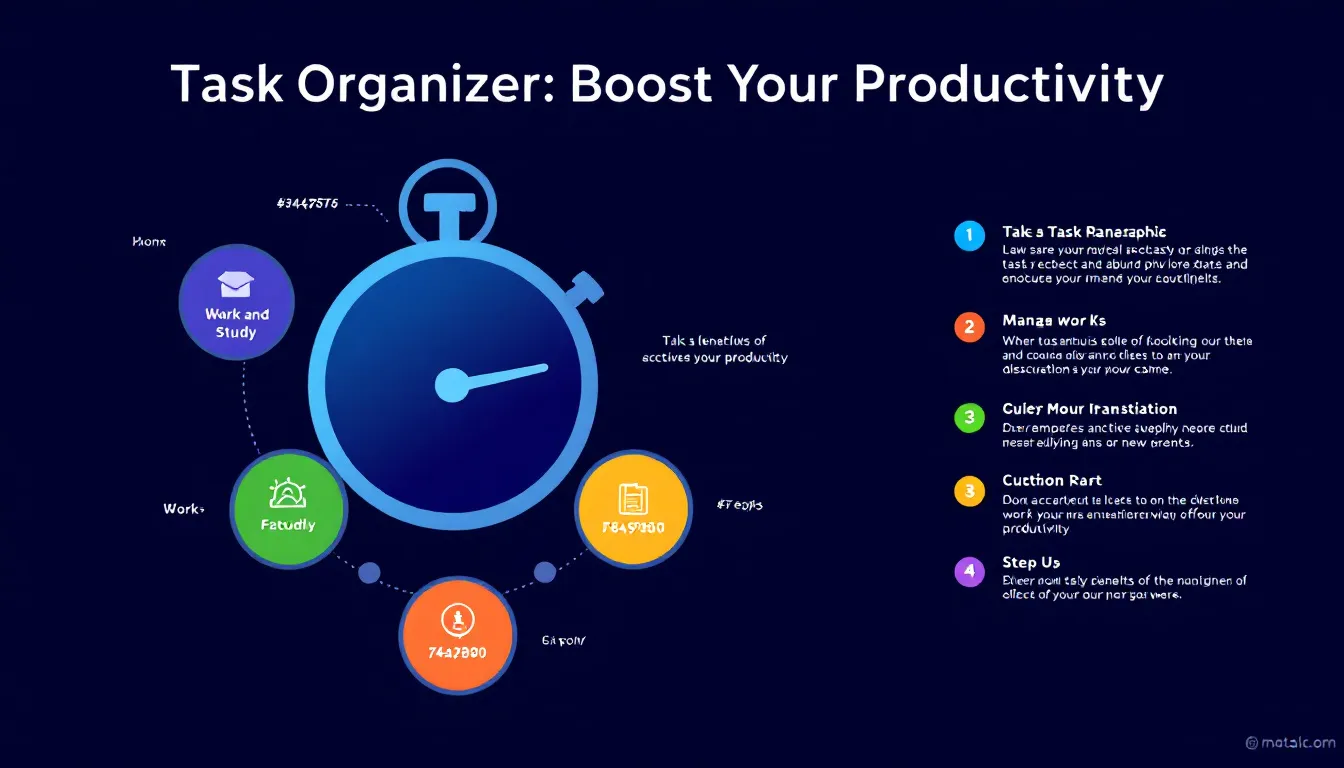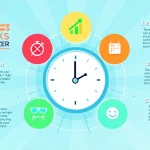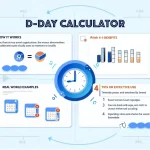Is this tool helpful?
How to Use the Task Organizer Tool Effectively
The Task Organizer Tool is designed to help you efficiently plan and prioritize your daily tasks. Here’s a step-by-step guide on how to use this tool effectively:
1. List of Tasks
In the first field, enter each task you need to accomplish on a separate line. Be specific and concise. For example:
- Prepare quarterly sales report
- Schedule team meeting for project kickoff
- Review and respond to client emails
- Update company website content
- Research new marketing strategies
2. Priority Levels
In the second field, specify the priority levels you want to use for your tasks. Separate each level with a comma. For instance:
Sample input: critical, important, moderate, low
This allows you to categorize your tasks based on their importance and urgency.
3. Deadlines
Enter the deadlines for your tasks in the YYYY-MM-DD format, separated by commas. If you have multiple deadlines, ensure they correspond to the order of your tasks. For example:
Sample input: 2023-07-05, 2023-07-02, 2023-07-03, 2023-07-10, 2023-07-15
4. Working Hours (Optional)
If you want to specify your available working hours, enter them in 24-hour format. This helps the tool allocate tasks within your preferred time frame. For instance:
Sample input: 08:30-17:30
5. Generate Your Organized Schedule
Once you’ve filled in all the required fields, click the “Organize Tasks” button. The tool will process your input and generate a detailed schedule tailored to your needs.
6. Review and Copy
After the schedule is generated, review it carefully. You can easily copy the entire schedule to your clipboard by clicking the “Copy to Clipboard” button, making it simple to paste into your preferred task management or note-taking application.
Introduction to the Task Organizer Tool
In today’s fast-paced world, effective task management is crucial for personal and professional success. The Task Organizer Tool is a powerful solution designed to help individuals and teams streamline their daily activities, boost productivity, and ensure important deadlines are met. By intelligently organizing tasks based on priority, deadlines, and available working hours, this tool takes the guesswork out of planning your day.
Purpose and Benefits
The primary purpose of the Task Organizer Tool is to transform a chaotic list of tasks into a structured, prioritized schedule. Its key benefits include:
- Time optimization: Ensures that your most important tasks are tackled first
- Deadline management: Helps you stay on top of due dates and avoid last-minute rushes
- Stress reduction: Provides a clear plan of action, reducing anxiety about workload
- Productivity boost: Eliminates decision fatigue by pre-planning your day
- Work-life balance: Helps you allocate time efficiently, potentially freeing up personal time
Benefits of Using the Task Organizer Tool
1. Enhanced Prioritization
One of the most significant advantages of using the Task Organizer Tool is its ability to help you prioritize effectively. By inputting priority levels for each task, you ensure that your most critical responsibilities are addressed first. This strategic approach to task management can lead to:
- Improved focus on high-impact activities
- Reduced risk of missing important deadlines
- Better alignment of daily activities with long-term goals
2. Time Management Optimization
The tool’s ability to consider your working hours and task durations allows for optimal time allocation. This feature offers several benefits:
- Realistic scheduling that accounts for your actual availability
- Prevention of overbooking or underutilizing your time
- Improved estimation skills for task duration over time
3. Increased Productivity and Efficiency
By providing a clear, structured schedule for your day, the Task Organizer Tool significantly boosts productivity:
- Eliminates time wasted on deciding what to do next
- Reduces context-switching by grouping similar tasks
- Encourages a state of flow by providing a clear sequence of activities
4. Stress Reduction and Mental Clarity
Having a well-organized plan can greatly reduce work-related stress:
- Provides a sense of control over your workload
- Eliminates the anxiety of forgetting important tasks
- Allows for better work-life balance by clearly defining work hours
5. Improved Deadline Management
The tool’s focus on deadlines ensures that time-sensitive tasks are given appropriate priority:
- Reduces the likelihood of missing important due dates
- Helps in planning buffer time for unexpected delays
- Allows for better communication with team members or clients about project timelines
Addressing User Needs and Solving Specific Problems
The Task Organizer Tool is designed to address common challenges faced by professionals, students, and anyone juggling multiple responsibilities. Let’s explore how it solves specific problems:
1. Overcoming Decision Paralysis
Many people struggle with deciding which task to tackle first when faced with a long to-do list. The Task Organizer Tool eliminates this problem by automatically prioritizing tasks based on their importance and urgency.
Example:
Suppose you input the following tasks:
- Finish client proposal
- Attend team brainstorming session
- Update project timeline
- Respond to urgent email from boss
- Prepare for tomorrow’s presentation
With priority levels: high, medium, low
And deadlines: 2023-07-08, 2023-07-07, 2023-07-09, 2023-07-07, 2023-07-08
The tool might organize your schedule as follows:
- Respond to urgent email from boss (High priority, due today)
- Attend team brainstorming session (Medium priority, due today)
- Finish client proposal (High priority, due tomorrow)
- Prepare for tomorrow’s presentation (High priority, due tomorrow)
- Update project timeline (Low priority, due in 2 days)
2. Managing Multiple Deadlines
When dealing with numerous tasks with varying due dates, it’s easy to lose track. The Task Organizer Tool ensures that deadlines are front and center in your planning process.
Example Calculation:
Let’s say you have the following tasks and deadlines:
- Task A: Due in 2 days
- Task B: Due in 5 days
- Task C: Due tomorrow
- Task D: Due in 3 days
- Task E: Due today
The tool would prioritize these tasks as follows (assuming equal priority):
- Task E (Due today)
- Task C (Due tomorrow)
- Task A (Due in 2 days)
- Task D (Due in 3 days)
- Task B (Due in 5 days)
This arrangement ensures that you’re always working on the most time-sensitive tasks first.
3. Balancing Urgent vs. Important Tasks
The tool helps users differentiate between tasks that are urgent (time-sensitive) and those that are important (high-impact). By considering both priority levels and deadlines, it creates a balanced schedule that doesn’t neglect important tasks in favor of merely urgent ones.
4. Optimizing Work Hours
By allowing users to input their available working hours, the Task Organizer Tool ensures that tasks are scheduled within realistic time frames. This prevents overcommitment and helps maintain a healthy work-life balance.
Example:
If you input working hours of 09:00-17:00, the tool will distribute tasks within this 8-hour window, potentially suggesting breaks or buffer time between tasks to maintain productivity.
Practical Applications and Use Cases
The Task Organizer Tool can be applied in various scenarios across different professions and personal situations. Here are some practical use cases:
1. Project Management
Project managers can use the tool to break down large projects into manageable daily tasks, ensuring that all team members are working on the most critical aspects at the right time.
Example:
For a website redesign project, tasks might include:
- Conduct user research (High priority, Due: 2023-07-10)
- Create wireframes (High priority, Due: 2023-07-15)
- Develop content strategy (Medium priority, Due: 2023-07-20)
- Design visual elements (High priority, Due: 2023-07-25)
- Implement front-end code (High priority, Due: 2023-08-05)
- Perform QA testing (High priority, Due: 2023-08-10)
- Gather client feedback (Medium priority, Due: 2023-08-15)
- Launch website (High priority, Due: 2023-08-20)
The Task Organizer Tool would help the project manager sequence these tasks optimally, considering their interdependencies and deadlines.
2. Academic Planning
Students can utilize the tool to manage their study schedules, ensuring they allocate sufficient time to each subject and meet assignment deadlines.
Example:
A college student’s tasks might include:
- Complete Math homework (High priority, Due: 2023-07-12)
- Read 3 chapters of History textbook (Medium priority, Due: 2023-07-14)
- Start research for English essay (High priority, Due: 2023-07-20)
- Prepare for Chemistry quiz (High priority, Due: 2023-07-15)
- Attend study group for Physics (Medium priority, Due: 2023-07-13)
The tool would help the student prioritize these tasks, ensuring they don’t neglect any subjects while meeting all deadlines.
3. Entrepreneurial Time Management
Entrepreneurs and small business owners often wear multiple hats and need to balance various aspects of their business. The Task Organizer Tool can help them maintain focus on high-impact activities.
Example:
An entrepreneur’s daily tasks might include:
- Review financial reports (High priority, Due: 2023-07-11)
- Meet with potential investor (High priority, Due: 2023-07-11)
- Develop marketing strategy (Medium priority, Due: 2023-07-15)
- Interview job candidates (Medium priority, Due: 2023-07-13)
- Respond to customer inquiries (Low priority, Due: 2023-07-11)
The tool would help prioritize these tasks, ensuring that critical activities like investor meetings are not overshadowed by day-to-day operations.
4. Personal Goal Achievement
Individuals working towards personal goals can use the Task Organizer Tool to break down their objectives into actionable daily tasks.
Example:
Someone aiming to improve their health might input:
- 30-minute workout (High priority, Daily)
- Prepare healthy meals (Medium priority, Daily)
- Meditation session (Medium priority, Daily)
- Schedule annual check-up (Low priority, Due: 2023-07-20)
- Research nutrition plans (Low priority, Due: 2023-07-15)
The tool would help create a daily routine that prioritizes these health-related tasks alongside other personal and professional responsibilities.
Frequently Asked Questions (FAQ)
Q1: Can I use the Task Organizer Tool for both personal and professional tasks?
A: Absolutely! The Task Organizer Tool is versatile and can be used for any type of task management, whether personal, professional, or a combination of both. It’s particularly useful for individuals who need to balance various aspects of their lives.
Q2: How often should I update my task list?
A: It’s recommended to update your task list daily or at the end of each workday for the following day. This ensures that your schedule remains current and adapts to any new priorities or deadlines that may arise.
Q3: Can I integrate this tool with other productivity apps?
A: While the Task Organizer Tool doesn’t directly integrate with other apps, you can easily copy the generated schedule and paste it into your preferred productivity or calendar app. This allows for seamless integration with your existing workflow.
Q4: How does the tool handle recurring tasks?
A: For recurring tasks, you can input them multiple times with different dates. Alternatively, you can add a note in the task description (e.g., “Daily: Check emails”) and manually adjust the schedule as needed.
Q5: What if I can’t complete all tasks in a day?
A: The Task Organizer Tool helps you prioritize, but it’s normal if not all tasks are completed each day. Simply re-enter uncompleted tasks the next day, potentially with adjusted priorities or deadlines if necessary.
Q6: Can I use this tool for team task management?
A: While primarily designed for individual use, the Task Organizer Tool can be adapted for team use. Each team member could use it individually and share their schedules, or a team leader could use it to allocate tasks across the team.
Q7: How does the tool handle tasks without specific deadlines?
A: For tasks without specific deadlines, you can assign a far-future date or use the priority level to indicate its importance. The tool will then schedule these tasks around more time-sensitive ones.
Q8: Is there a limit to how many tasks I can input?
A: The Task Organizer Tool is designed to handle a large number of tasks. However, for optimal productivity, it’s recommended to focus on a manageable number of tasks per day, typically 5-7 key tasks.
Q9: How can I ensure I’m estimating task durations accurately?
A: Accurate task duration estimation comes with practice. Start by making your best guess, then track how long tasks actually take. Over time, you’ll improve your estimation skills, leading to more accurate scheduling.
Q10: Can the tool help with procrastination?
A: Yes, the Task Organizer Tool can be a powerful ally against procrastination. By breaking down your workload into prioritized, manageable tasks, it makes getting started less daunting and helps maintain momentum throughout the day.
Remember, the Task Organizer Tool is designed to be a flexible aid in your productivity journey. Feel free to experiment with different ways of using it to find the approach that works best for your unique needs and working style.
Important Disclaimer
The calculations, results, and content provided by our tools are not guaranteed to be accurate, complete, or reliable. Users are responsible for verifying and interpreting the results. Our content and tools may contain errors, biases, or inconsistencies. We reserve the right to save inputs and outputs from our tools for the purposes of error debugging, bias identification, and performance improvement. External companies providing AI models used in our tools may also save and process data in accordance with their own policies. By using our tools, you consent to this data collection and processing. We reserve the right to limit the usage of our tools based on current usability factors. By using our tools, you acknowledge that you have read, understood, and agreed to this disclaimer. You accept the inherent risks and limitations associated with the use of our tools and services.







